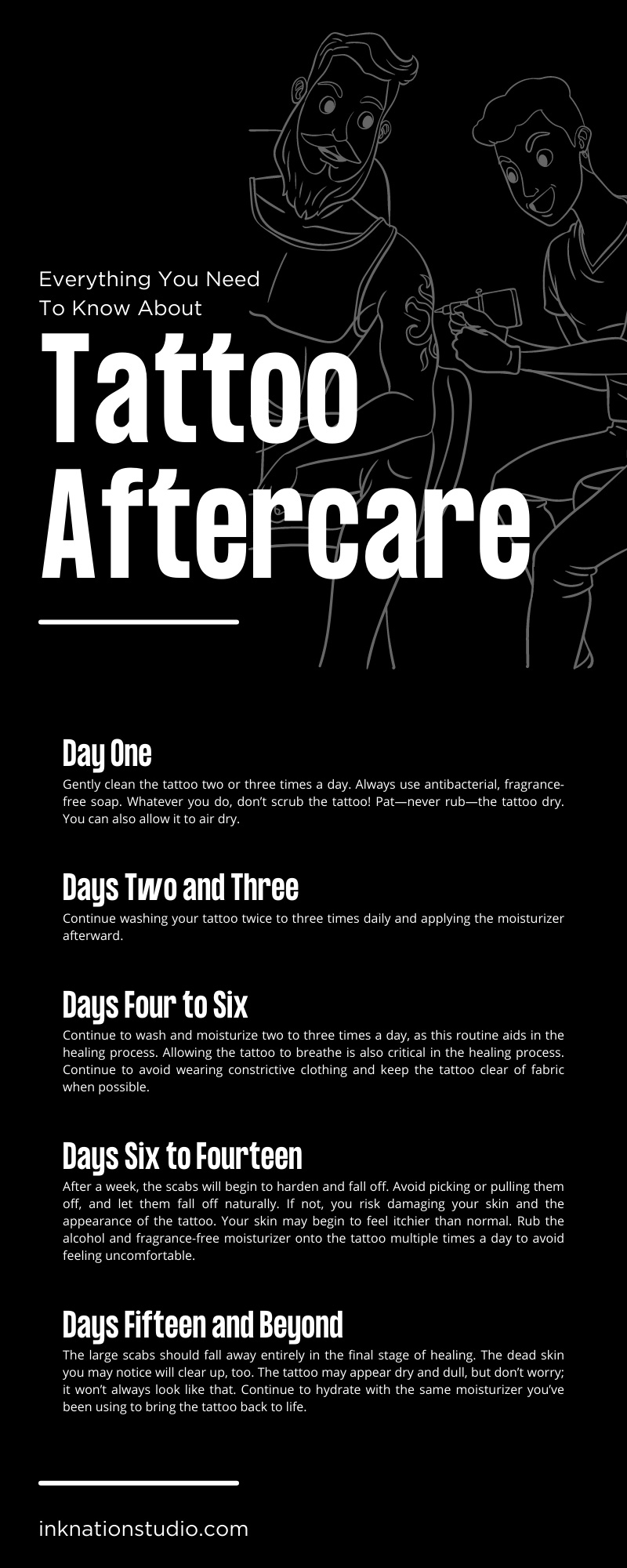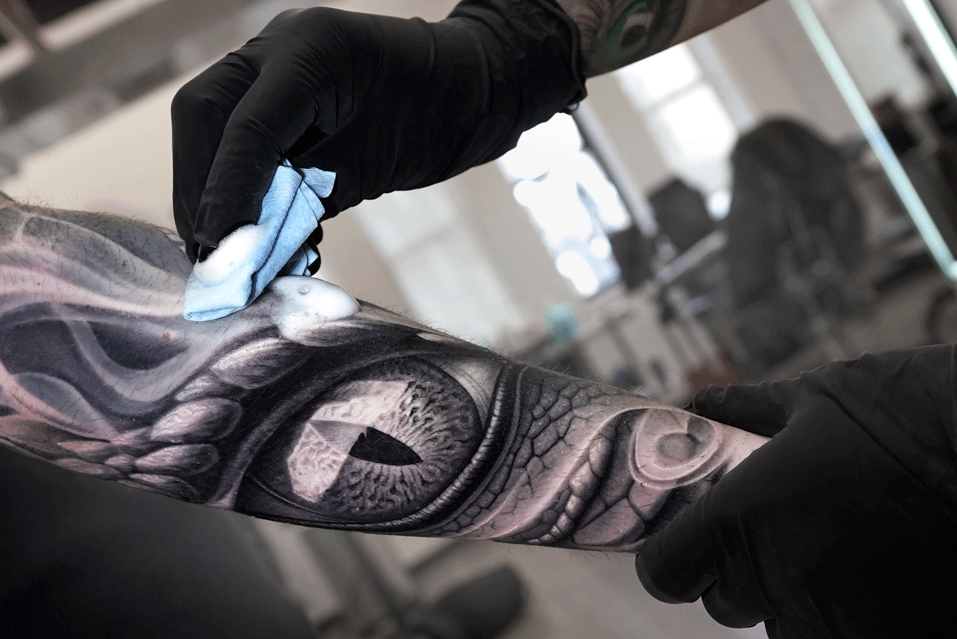Getting a new tattoo is an exciting time for every tattoo enthusiast. You’ve done all the planning, sat through the tattoo itself, and now it’s time to let the tattoo heal. You want to ensure your tattoo heals correctly and you provide proper care as your skin recovers. Read on to learn everything you need to know about tattoo aftercare so that you can successfully heal.
The Importance of Aftercare
A tattoo is a way for individuals to show off their style. You took time to plan and work with an artist to create the piece of art before inking it onto your body. Caring for the tattoo is incredibly important because you want the tattoo to heal correctly. Believe it or not, tattoos are a medical procedure. The artist uses a needle to insert ink underneath your skin. You’re susceptible to infection and scarring in any situation where you open the skin, and tattoos are no exception.
Proper care can prevent infections, scarring, and other complications to ensure the tattoo heals correctly. It’s important to start by choosing a reputable and licensed tattoo artist. Choose a shop like Ink Nation Studio, the premier tattoo studio in NYC. We have the knowledge and expertise to keep you safe during the process. Plus, we only use high-quality equipment for the tattoo.
Some states don’t require tattoo studios and artists to provide aftercare instructions. The areas that do require shops to provide aftercare instructions let the studio decide what information is important enough to make available. This inconsistency makes figuring out proper care tricky for clients who collect work from many different shops or lack experience with tattoo aftercare.
Cover the Tattoo
In many cases, after the artist completes the piece, they’ll cover it with a thin layer of antibiotic ointment and then cover it with plastic wrap or a medical-grade adhesive barrier. The cover helps stop bacteria from entering your skin and prevents your clothing from irritating the fresh tattoo.
Your artist will tell you how long to keep the covering on. Most tattoo artists recommend you leave the cover on for at least one hour, as it will help contain excess ink or fluids leaking from the tattoo.
Allow the Tattoo To Heal
Your new tattoo needs time to heal. Wear sun-protective clothing whenever you go outside. Call your doctor or tattoo artist immediately if you begin to experience any infection symptoms. These steps are crucial in allowing the tattoo to heal.
A few things to avoid while your tattoo heals include:
-
- Don’t scratch or pick at the tattoo.
-
- Don’t go swimming.
-
- Don’t apply sunblock on your healing tattoo.
-
- Don’t wear tight clothing over the tattoo.
Wash the Tattoo Gently
Before you remove the covering, ensure you wash your hands. You don’t want any bacteria or germs in the open wound. Once you remove the covering, wash the tattoo with fragrance-free soap and warm water. It’s crucial you do this step gently, as you could hurt your skin otherwise.
After cleaning the tattoo, use an alcohol and fragrance-free moisturizer. Don’t reapply a covering unless your tattoo artist provided specific instructions on how to do so—you want to allow the skin to breathe.
Day-by-Day Tattoo Aftercare
The more intricate the tattoo, the longer it will take to heal. Larger tattoos will stay swollen and red longer than smaller ones because the lengthy process causes more trauma to the skin.
Day One
Ask your artist how long to leave the covering on, and don’t take it off earlier than advised. Each artist will have their recommendations based on tattoo size and style. Some will suggest waiting one to two hours, and others will recommend longer than 24 hours.
You’ll likely notice some fluid coming from the tattoo after removing the plastic wrap or bandage. This liquid is plasma (the clear part of the blood) and ink. Your skin will feel sore and slightly warm when you touch it. You may also notice redness around the tattoo.
Gently clean the tattoo two or three times a day. Always use antibacterial, fragrance-free soap. Whatever you do, don’t scrub the tattoo! Pat—never rub—the tattoo dry. You can also allow it to air dry. Ask your artist if they have any specific products they recommend you use throughout the healing process.
Days Two and Three
On the second day, your tattoo will appear cloudier and duller, which is normal for healing skin. You’ll also notice scabs beginning to form. Continue washing your tattoo twice to three times daily and applying the moisturizer afterward.
Don’t become alarmed if you notice ink running into the sink while you wash that tattoo. It’s only excess ink coming up through your skin, and it’s completely normal. Your tattoo artist may warn you of this happening so that you don’t feel panicked when you see it.
Days Four to Six
During this time, you’ll begin to notice the redness fading and more scabbing occurring. These scabs won’t be the thick ones you’re used to when you undergo a deep injury, such as a cut. Instead, the scabs will follow along with the strokes of the tattoo artist’s needles. You should avoid picking at the scabs because lifting the dead skin can bring some healing skin with it, leading to scarring.
Continue to wash and moisturize two to three times a day, as this routine aids in the healing process. Allowing the tattoo to breathe is also critical in the healing process. Continue to avoid wearing constrictive clothing and keep the tattoo clear of fabric when possible.
Days Six to Fourteen
After a week, the scabs will begin to harden and fall off. Avoid picking or pulling them off, and let them fall off naturally. If not, you risk damaging your skin and the appearance of the tattoo.
Your skin may begin to feel itchier than normal. Rub the alcohol and fragrance-free moisturizer onto the tattoo multiple times a day to avoid feeling uncomfortable.
If your tattoo is still swollen and red a week out, you may have an infection. Call your doctor or tattoo artist immediately if you suspect you have an infection. You’ll need medical attention to clear up the issue, and professionals can advise you on what the next steps are for your specific healing needs.
Days Fifteen and Beyond
The large scabs should fall away entirely in the final stage of healing. The dead skin you may notice will clear up, too. The tattoo may appear dry and dull, but don’t worry; it won’t always look like that. Continue to hydrate with the same moisturizer you’ve been using to bring the tattoo back to life.
The outer layers of the skin should heal by the second or third week, but the deeper, lower layers will take longer. It could take anywhere from three to four months for those layers to finish healing completely. The tattoo should look vibrant and healed by the end of the third month.
We hope this brings clarity regarding tattoo aftercare. You spent the time and money planning and receiving the tattoo and want to care for it correctly. Follow the above tips as you navigate the healing process.



